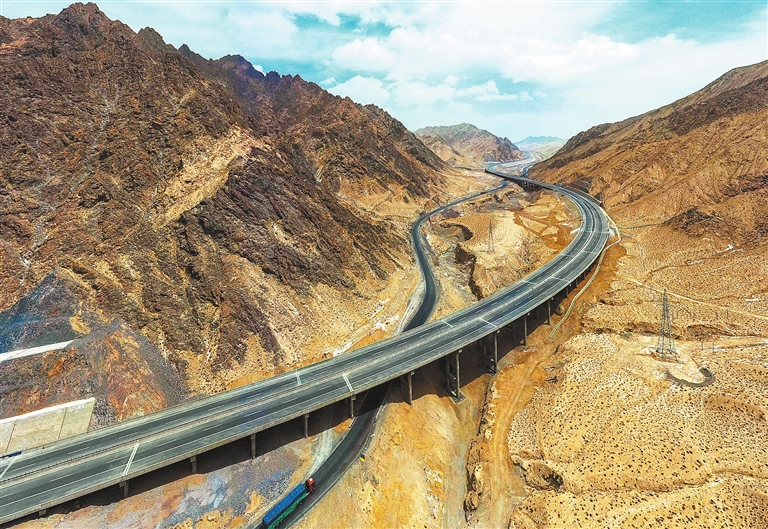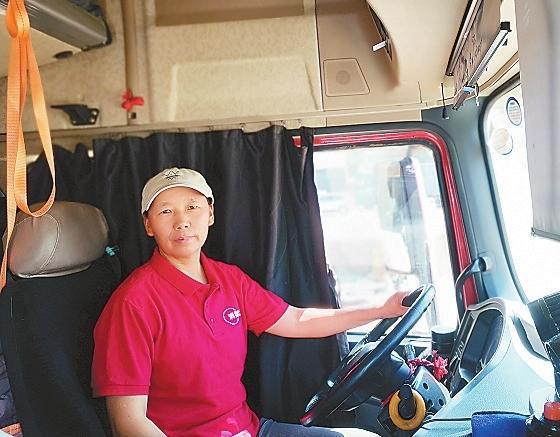

ON the remote Ruoqiang section of a national highway in Northwest China’s Xinjiang Uygur Autonomous Region, Xie Lin transports 30 tons of goods on her 17-meter-long truck. Most of the time, she is greeted only by the sand dunes and poplar trees of the endless Gobi Desert. “Although some drivers say it’s hard, I feel relaxed holding the steering wheel, enjoying the vast landscape while listening to music,” she said. Xie, a 54-year-old truck driver from East China’s Anhui Province, works for a logistics company in her home province. Of some 1,300 truck drivers hired by the company, she is the only female. “Many customers call me ‘superwoman’ when they see me driving long distance to deliver goods all by myself,” she said. Since 1995 when she joined the company, Xie has racked up over 5 million kilometers. Her routes, most often, were between Anhui and Xinjiang. Her affection for trucks traces back to her childhood. When she was 10, her father retired from the army and worked as a truck driver in the fleet of a cement factory in today’s Suzhou City in Anhui. “Back then, I would rush to the fleet after school and learned to repair vehicles with my father and his colleagues,” she said. On weekends, members of the fleet would take her to the surrounding cities to deliver cement. In 1989, at 20, she got her driver’s license. In 1995, she bought a second-hand truck and started working for the logistics company in Huaibei, Anhui Province. In 2003, Xie and her brother began to deliver goods from the Yangtze River Delta to Xinjiang. During one trip, they ran into trouble. They were transporting washing machines and refrigerators from the coastal city of Ningbo to Xinjiang. When they arrived in Northwest China’s Gansu Province, the road was closed due to the construction of the Lianyungang-Horgos Expressway, linking the city of Lianyungang in East China’s Jiangsu Province with Horgos in Xinjiang. Xie had to take a detour down a temporary track through the desert. However, as the road was uneven, the coupler joining the trailer and truck broke, and the goods fell to the ground. “My brother stayed there to keep watch on the goods, while I drove about 80 kilometers to a repair site. It took me two days to get the truck repaired and return,” she recalled. In 2005, her brother bought his own truck, and she had to drive alone. “At that time, in Xinjiang, I mostly took the national highways, although sometimes I had to take the desert roads and the small roads that were not even on the maps.” On Dec. 31, 2014, the Lianyungang-Horgos Expressway fully opened to traffic. The roads in China have become wider and smoother in recent years, and transportation is done much more efficiently. “It used to take nine days from Hangzhou, capital of east China’s Zhejiang Province, to Urumqi, the regional capital of Xinjiang. But now, the same journey can be made in four days and four nights,” she said. The Ruoqiang section of No. 218 national highway, on which Xie often drives, is a testament to Xinjiang’s road development. Next to a brick road put into use in 1971 is the national highway, which opened to traffic in 2001, as well as an expressway and a railway, which were opened to traffic in recent years. By September 2022, the total length of highways in Xinjiang had reached 217,300 km and the total length of expressways in the region exceeded 10,000 km, according to the regional transport department. Some 20 years ago, most of the cargo Xie transported to Xinjiang consisted of small household appliances. Since 2014, quantities of solar panels made a large proportion. “There are more and more photovoltaic power stations and wind power projects in Xinjiang,” she said. She has also witnessed the improving ecological environment, as evidenced by more spotting of wild animals. “In southern Xinjiang, animals like the lynxes and Tibetan antelopes are often spotted,” she said, adding that the autonomous region has built animal passages along highways and railways, and has set up signboards to remind people to drive carefully. Xie has made many friends in Xinjiang, some of whom would drive a long way to meet her. “Xinjiang is my second home,” she said. In January, Xie was elected as a deputy to the Anhui provincial people’s congress. She proposed building more “driver’s homes” at highway service zones, where they can rest, take showers and do their laundries. Xie plans to retire in two years. “I had thought about finding another job, but found it hard to stay in one place,” she said. “I see beautiful sceneries of different places on the road. I witnessed the changes of Xinjiang, and made a lot of friends.”(Xinhua) | 
